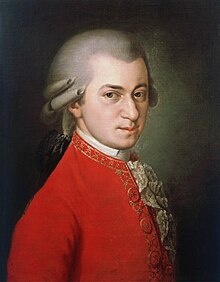Symphony No. 3 (Mozart)

The Symphony No. 3 in E♭ major, K. 18, once attributed to Wolfgang Amadeus Mozart, is by today's scholarship considered not to be Mozart's own work but instead that of Carl Friedrich Abel, a leading German composer of the earlier Classical period.
It was misattributed to Mozart because a manuscript score in the hand of Mozart was categorized as his Symphony No. 3 and was published as such in the first complete edition of Mozart's works by Breitkopf & Härtel. Later, it was discovered that this symphony was actually the work of Abel, copied by the boy Mozart (evidently for study purposes) while he was visiting London in 1764. That symphony was originally published as the concluding work in Abel's Six Symphonies, Op. 7. However, Mozart's copy differs from Abel's published score in that Mozart "substituted clarinets for the printed oboe parts".[1]

It is in three movements:
- Molto allegro
- Andante
- Presto
References[]
- ^ H. C. Robbins Landon, "Doubtful and spurious" The Mozart Compendium, ed. H. C. Robbins Landon. London: Thames & Hudson (1990): 353
External links[]
- Symphony No. 3 (Abel): Scores at the International Music Score Library Project
- Symphonies by Wolfgang Amadeus Mozart
- Compositions in E-flat major
- Mozart: spurious and doubtful works
- Symphony stubs